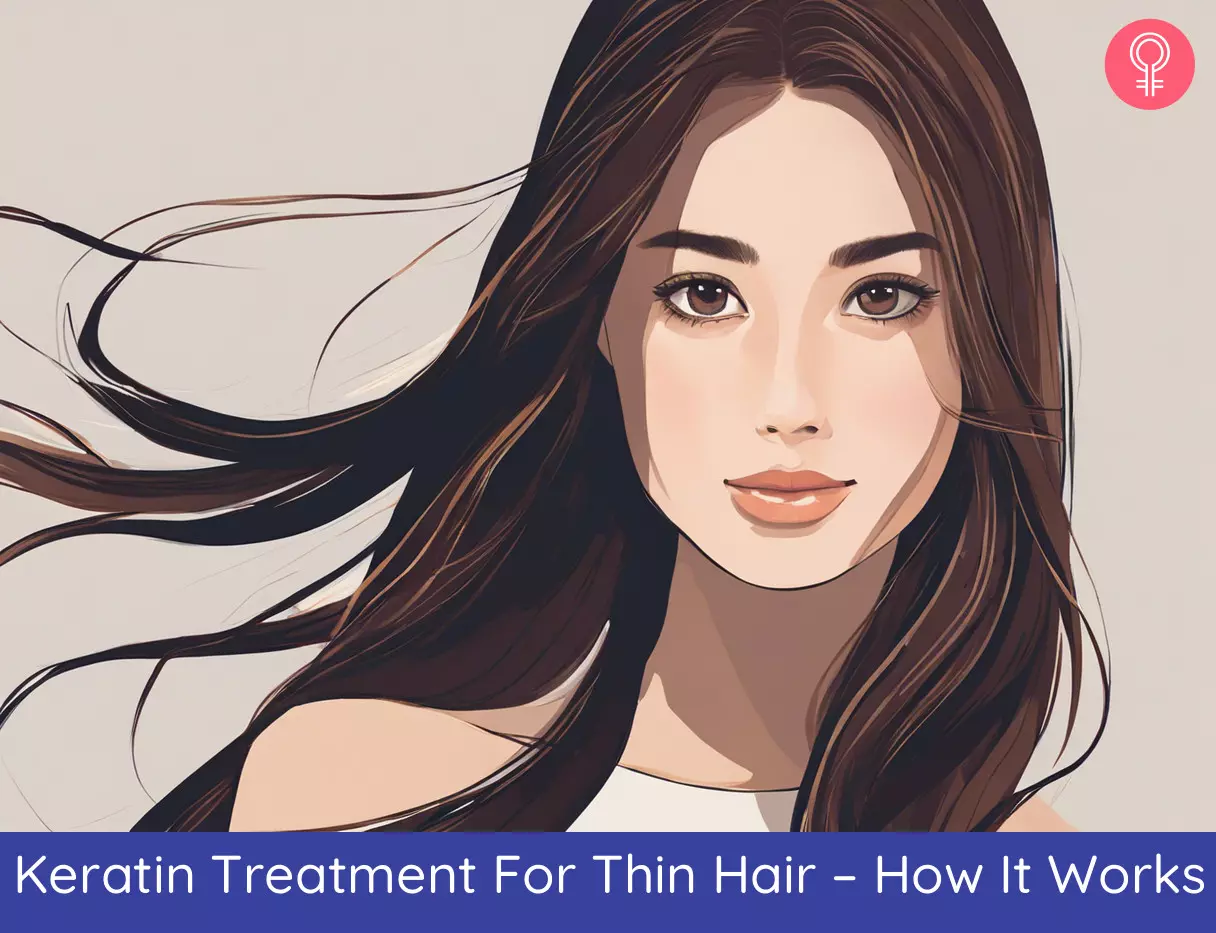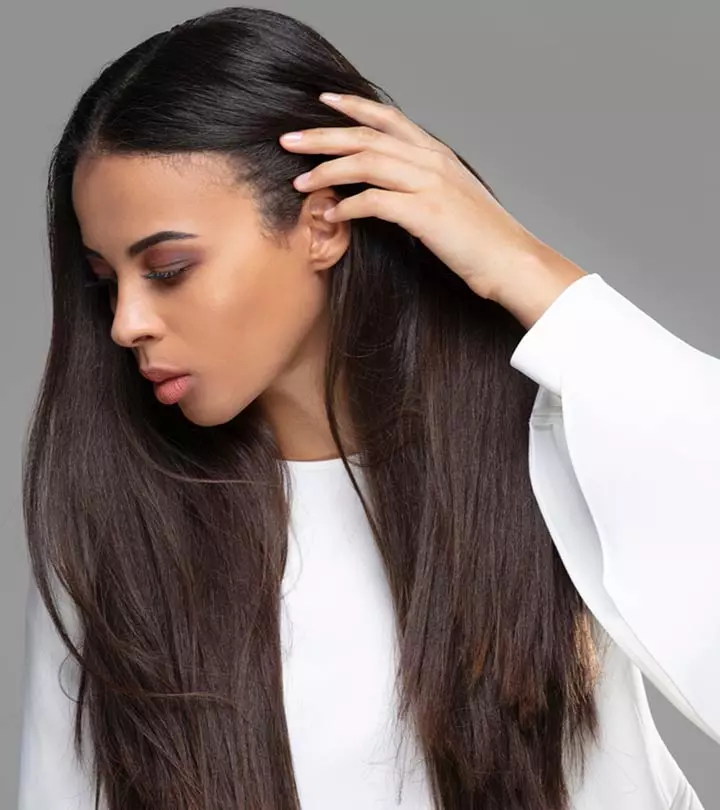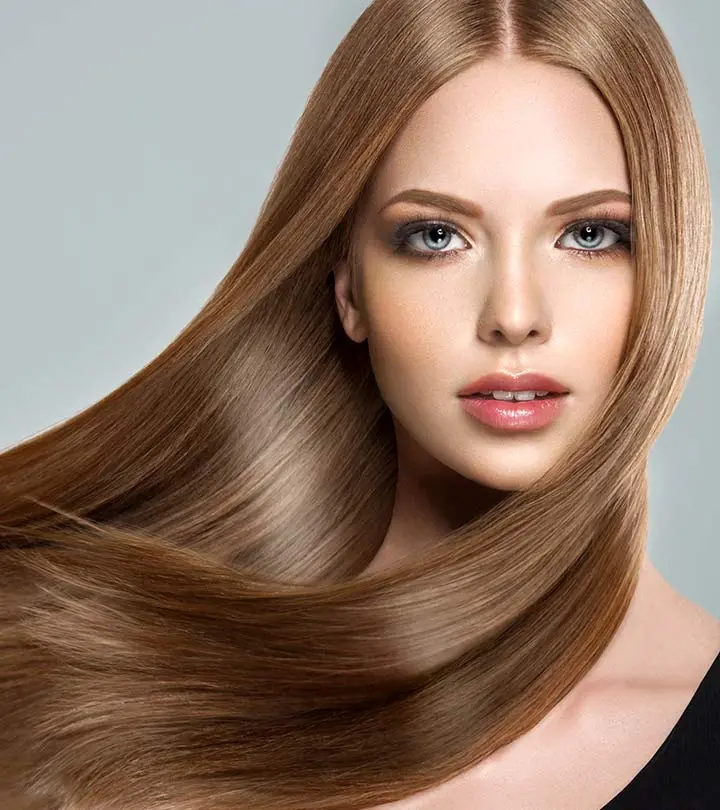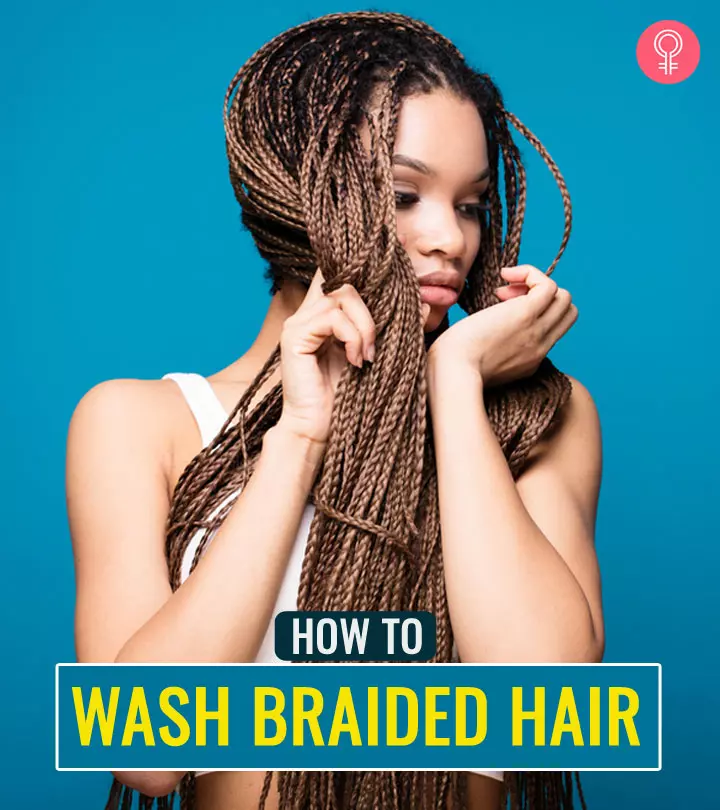Keratin Treatment For Thin Hair – How It Works
Learn if this treatment is the best choice for your hair and alternatives to try.

Image: Shutterstock
No, keratin does not thicken hair. Thus, it may not be a good hair treatment for thin hair. But it does protect it from damage. Keratin does wonders for the hair. But what is the verdict on undergoing keratin hair treatment for thin hair? Thin hair gets greasy quickly and ends up looking flat and dull. This treatment might make your thin locks look flatter and even more lifeless. But if keratin strengthens hair, shouldn’t it increase your hair thickness, making thin hair look fuller? Learn if keratin treatments improve hair thickness, their possible risks, and the available alternatives. Keep reading.
In This Article
Does Keratin Thicken Hair?

No, keratin does not thicken hair, but it protects it from damage. Keratin products are mainly used to smoothen hair out. Human hair consists of hard keratins that contain 65-95% of proteins, 1-9% of lipidsi Fatty substances that regulate what enters and exits the body’s cells, store energy, absorb vitamins, and produce hormones. , 3% of melanini A natural pigment found in organisms that originates from the amino acid tyrosine, which provides color to hair, skin, and eyes , and a few other minor compounds (1). Keratin is formed by the epithelial cellsi Cells present on the inside of your body and on its surface, like in and around the blood vessels, organs, and on the skin during the hair growth phase. It protects the epithelial cells from physical damage.
However, protein hydrolysates (protein bonds already broken into dipeptides and tripeptides), like hydrolyzed keratin, have low molecular weights and can protect hair from environmental and chemical damage (2). Keratin hydrolysates are obtained from nails, wool, horns, and feathers of animals. Vegetable options for keratin hydrolysates include soy, wheat, and corn, though they are not as effective as the keratin obtained from humans and animals.
When keratin hydrolysates extracted from feathers were placed on cuticle scales, they sealed the cuticles and protected the hair from heat damage. These hydrolysates also enhanced hair color and shine. The positive charges of protein hydrolysates neutralize the negative charges of damaged hair. They reduce any interfiber frictioni Friction caused due to the overlapping of hair fibers that happens on the cuticles of hair strands and frizz. In the following section, we will look into the keratin treatment process in detail.
Roopa Vikesh, a lifestyle blogger, writes about a keratin treatment she had done at the local parlor that helped straighten and smoothen out her hair. She adds, “My hair’s thinning awfully at the top, and seeing hair in my drain would make me want to weep. The keratin/botoplex treatments prevent hair fall, and it makes my hair resist fall (i).”
Key Takeaways
- Keratin treatment gives your hair extra shine, helps keep it healthy, and improves heat protection.
- The treatment smoothens and straightens your hair with a mixture of formaldehyde solution, conditioners, and keratin hydrolysates.
- Keratin-based shampoos, conditioners, and hair masks can make your hair smoother and more manageable.
What Is The Keratin Treatment Process?

The keratin treatment was started in Brazil. It uses a blend of formaldehyde solution, conditioners, and keratin hydrolysates to smoothen and straighten hair. Lately, this formaldehyde solution has been replaced by formaldehyde releasers, which are safer alternatives. The process involves saturating your hair with a formaldehyde solution, drying it out, and using a flat iron to lock your hair in a straight position (2). However, the chemicals used for smoothing hair are not as strong as those used in hair straightening treatments. This makes the keratin treatment less damaging (though it is not ideal for all hair types).

The hair is straightened when water breaks the hydrogen bonds of the keratin molecule. It is then blow-dried straight (a flat iron can also be used). The newly redesigned keratin remains in this shape as the formaldehyde crosslinks the keratin filaments in a perfect alignment (2).
 Quick Tip
Quick TipKeratin treatment is often compared with Brazilian blowouts. How are the two approaches different?
Keratin Treatment Vs. Brazilian Blowout
Keratin treatments and Brazilian blowouts are both popular hair-smoothing procedures, but with some key differences. Keratin treatments primarily aim to relax curls, reduce frizz, and add shine by infusing the hair with natural protein. They help make hair smoother and more manageable.
Brazilian blowouts, on the other hand, are more intense. They use a liquid keratin solution that bonds to the hair, which is then sealed with a flat iron. This creates a protective layer around each strand. This process aims to improve hair strength, block frizz, and enhance shine.
Both treatments enhance hair smoothness and manageability. But while Brazilian blowouts have a more immediate effect, keratin treatments are more focused on long-term hair health.
That said, do note that the keratin treatment may also cause certain side effects. Learn more in the next section.
Side Effects Of The Keratin Treatment

- Research shows that the keratin extracted from plants cannot match that produced in humans. Hence, it cannot restore or treat damaged hair (2). Plus hair may appear flatter and lose volume due to the smoothing effect.
- Thin hair might become more prone to breakage or shedding after the treatment. It could worsen existing hair thinning or hair loss.
- The formaldehyde used in the keratin treatment is a classified carcinogeni Any substance or compound with the potential to cause cancer in the living tissues of humans or animals by the World Health Organization. However, the potential carcinogenic effects of formaldehyde are yet to be thoroughly studied(3).
- Ever since its invention, every salon in Brazil was performing the Brazilian Keratin Treatment (BKT). Consumers complained of burning eyes, mouth, nose, and a strong smell. Though the ingredients used today are based not on formaldehyde but formaldehyde-releasers, like methylene glycol or glyoxylic acid, even these substances can release formaldehyde when heated by a blow-dryer or a hot iron (4).
- Even professional hair smoothing treatments labeled formaldehyde-free can produce formaldehyde concentrations that meet or exceed current occupational exposure limits.
- Some believe that the formaldehyde concentrations in BKT products may exceed the recommended levels and serve as a health hazard.
- A study showed that formaldehyde caused a new onset of asthma (5).
- The keratin treatment process requires the flat hot iron to be applied to the hair surface 15 to 20 times on the same spot. This process can be quite aggressive and damage the integrity of the hair fiber proteins (2).
For another lifestyle blogger, keratin hair treatment was not what they had hoped it to be despite spending exorbitantly for it. “I got a keratin straightening treatment as I thought it would make the hair I did have stronger and also prevent me from using heat products. My hair fell out at triple the rate for six months after the treatment, it set me back hugely (ii),” they said.
The good news is there are alternatives to the keratin treatment process. Keep reading to know more about them.
Keratin Treatment Alternatives

- You may opt for hair products containing keratin. Shampoos, conditioners, smoothing serums, and masks that contain protein hydrolysates can help smooth hair and prevent frizz and interfiber friction.
- You can also use shampoos that have biotin as an ingredient. The biotin helps the hair shafts appear fuller.
- Hair fiber sprays can be used to give hair a thicker appearance. These hair fibers are made with keratin that is similar to human keratin. The hair fibers are usually positively charged and get attached to the negatively charged natural hair strands. They can be sprayed on and washed off.
- Having a hair care regimen is another good alternative. Oil and massage your hair and scalp regularly. Use hair masks to strengthen hair and prevent hair thinning and help with hair repair. Stop using heating tools too often.
- Have a healthy and balanced diet. A diet rich in protein, fiber, vitamins, and minerals can boost hair health. You can also take supplements for adequate nutrient intake.
- Use products with keratin to style your hair. These protect your hair from heat and chemical damage. They can also enhance hair shine and color.
 Quick Tip
Quick TipInfographic: Side Effects Of Keratin Treatment On Thin Hair + 5 Alternative Treatments
Despite its increasing popularity, keratin therapy may not suit all hair types. While it successfully reduces hair damage and provides the hair with a sleek and shiny appearance, a few side effects must be kept in mind. Check out the infographic below for better awareness of the keratin treatment and 5 alternative treatments that you can choose. Illustration: StyleCraze Design Team
Getting keratin treatment done on thin hair may leave it more flat and damaged. This treatment uses formaldehyde or formaldehyde resin to straighten your hair, which leaves it more prone to damage. It is better to use hair care products that contain keratin. Keratin protects the hair from any damage. You can look for animal-derived keratin hydrolysates or vegetable hydrolysates made from soy, corn, and wheat. You can also use hair styling products like leave-in conditioners. Remember to pair these products with a healthy diet that can boost your protein production and make your hair healthier.
Frequently Asked Questions
Does keratin cause hair thinning?
Yes, keratin treatment is a harsh procedure and may cause hair loss and thinning.
Does keratin treatment give volume?
No, on the contrary, it makes hair flatter by taming volume, curls, and frizz.
How long does keratin treatment for thin hair last?
Keratin treatment may last up to 5 or 6 months.
Can we oil hair after keratin treatment?
You should not oil your hair for at least 3 days (maybe more in some cases, depending on the type of keratin treatment) after keratin treatment. After that period, you may oil your hair with products recommended by your stylist.
Can I comb my hair after keratin treatment?
No, not immediately. It is better to wait at least 3 days before combing your hair if it is tangled up after a keratin treatment.
Illustration: Keratin Treatment For Thin Hair – How It Works

Image: Stable Diffusion/StyleCraze Design Team
You can opt for a keratin treatment to get thicker, healthier, and shinier hair in no time, but is it suitable for thin hair? Watch this video to know more.
Personal Experience: Source
StyleCraze's articles are interwoven with authentic personal narratives that provide depth and resonance to our content. Below are the sources of the personal accounts referenced in this article.
i. A Hair Smoothening Storyhttps://rovikesh.medium.com/a-hair-smoothening-story-ee3565c4162a
ii. I’ve spent over $3,000 on hair growth treatments, here’s what was worth the money
https://medium.com/@mycrappyhormonesblog/ive-spent-over-3-000-on-hair-growth-treatments-here-s-what-was-worth-the-money-6440c53557aa
References
Articles on StyleCraze are backed by verified information from peer-reviewed and academic research papers, reputed organizations, research institutions, and medical associations to ensure accuracy and relevance. Read our editorial policy to learn more.
- Human Hair Keratin and Its-Based Biomaterials for Biomedical Applications, https://www.researchgate.net/publication/271662533_Human_Hair_Keratin_and_Its-Based_Biomaterials_for_Biomedical_Applications
- Hair Cosmetics: an Overview,
https://www.ncbi.nlm.nih.gov/pmc/articles/PMC4387693/ - Formaldehyde Carcinogenicity Research: 30 Years and Counting for Mode of Action, Epidemiology, and Cancer Risk Assessment, https://www.ncbi.nlm.nih.gov/pmc/articles/PMC3893912/
- Hair-Smoothing Products That Release Formaldehyde When Heated, https://www.fda.gov/cosmetics/cosmetic-products/hair-smoothing-products-release-formaldehyde-when-heated
- Asthma from Hair Straightening Treatment Containing Formaldehyde: Two Cases and a Review of the Literature,
https://pubmed.ncbi.nlm.nih.gov/29554820/
Read full bio of Tiffany Young
Read full bio of Anjali Sayee
Read full bio of Eshna Das
Read full bio of Krati Darak


























Community Experiences
Join the conversation and become a part of our empowering community! Share your stories, experiences, and insights to connect with other beauty, lifestyle, and health enthusiasts.